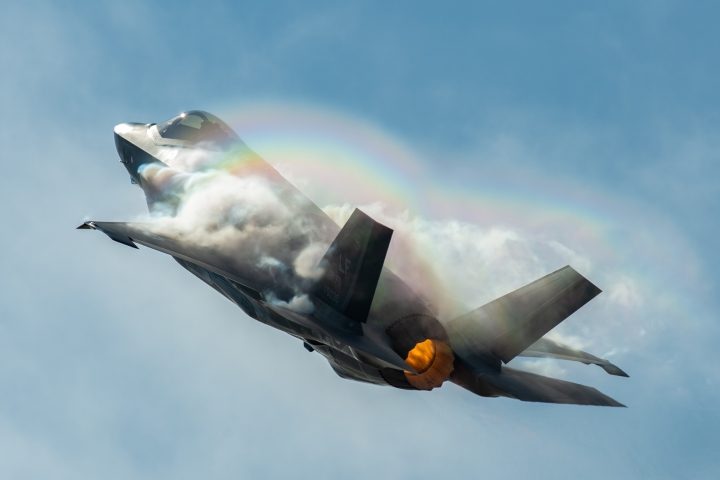
A Dutch appeals court on February 12 ordered the government to ban all exports of F-35 fighter jet parts to Israel over concerns they were being used to breach international law during Israel’s Gaza offensive.
It said the state had to abide by the order within seven days and rebuffed a request by government lawyers to suspend the order during an appeal to the Supreme Court. The state has eight weeks to appeal against the decision.
“It is undeniable that there is a clear risk that the exported F-35 parts are used in serious violations of international humanitarian law,” the court said.
The government said it would file an appeal at the Supreme Court, as it said the order had crossed the state’s responsibility to formulate its own foreign policy.
“The delivery of US F-35 parts to Israel in our view is not unjustified,” Trade Minister Geoffrey van Leeuwen said.
He said the F-35s were crucial for Israel’s security and its ability to protect itself from threats in the region, “for example from Iran, Yemen, Syria and Lebanon.”
Van Leeuwen said it was too early to say what effect the verdict would have on Israel.
“We are part of a big consortium of countries that are also working together with Israel, we will talk to partners about how to deal with this.”
The decision to appeal was not linked to the “very concerning” situation in Gaza, he added.
Israel’s massive aerial and ground offensive in the densely populated Gaza Strip has killed more than 28,000 Palestinians, per the enclave’s health authorities. Most of its 2.3 million residents have also been displaced.
On its end, Israel denies accusations of war crimes in its attacks on Gaza.
The offensive came after a Hamas terror attack on southern Israel on October 7 in which 1,200 Israelis were killed and around 250 were taken hostage.
Israeli government spokesperson Eylon Levy could not comment on the case specifically, but said Israel expects allies “to stand firmly by our side as we fight to bring Hamas to justice in the wake of the October 7 massacre.”
In a separate legal case in January, the UN’s International Court of Justice ordered Israel to take action to prevent acts of genocide in its war against Hamas. The ruling prompted renewed calls by human-rights groups to ban weapons exports to Israel.
The case against the Dutch government was brought by various human rights groups, including the Dutch affiliate of Oxfam, in December 2023.
“We hope this ruling will strengthen international law in other countries so that the citizens of Gaza are also protected by international law,” Oxfam Novib director Michiel Servaes said in a statement.
In a first ruling in December, a Dutch lower court had stopped short of asking the Dutch government to halt the exports, even though it said it was likely that F-35s contributed to violations of the laws of war.
However, where the lower court ruled the state had a large degree of freedom in weighing political and policy issues to decide on arms exports, the appeals court said such concerns did not trump the clear risk of violations of international law.
Furthermore, the appeals court also said it was likely that the F-35s were being used in attacks on Gaza, leading to unacceptable civilian casualties. It dismissed the Netherlands’ argument that it did not have to do a new check on the permit for the exports.
The Netherlands hosts one of several regional warehouses of U.S.-owned F-35 parts, from which the parts are distributed to countries that request them, including Israel in at least one shipment since the October 7 attacks.
Presiding Judge Bas Boele said there was a possibility the Dutch government could allow the export of F-35 parts to Israel in future, but only on the strict condition they would not be used in military operations in Gaza.
On February 11, the Israel Defense Forces (IDF) claimed that Mohamed Washah, a Palestinian journalist working for Al Jazeera, is simultaneously working as a senior militant with the Hamas terrorist group.
Lieutenant Colonel Avichay Adraee, an Arabic-language spokesman for the IDF, released assorted images allegedly depicting the reporter handling military hardware during apparent Hamas training exercises. The weaponry that Washah is said to have handled included a mounted RPG and homemade warheads for it, as well as a crude strike drone.
“In the morning, he’s a journalist on the Al Jazeera channel, and in the evening, a terrorist in Hamas!” Adraee claimed.
The incriminating imagery was recovered from a laptop seized a few weeks ago from a Hamas compound in the north of Gaza, the spokesman added. Documents recovered from the laptop indicated that the journalist was actually a “prominent commander” of an anti-tank unit with Hamas, as well as a member of its air unit’s research and development group since late 2022, Adraee stated.
Besides, Adraee suggested that more revelations about alleged Hamas militants disguised as journalists could be done in the near future. “Who knows how many details we will reveal about the presence of other terrorists in journalistic garb in the near future,” he wrote.
Washah has been featured in various Al Jazeera broadcasts from the region in recent months. Thus far, neither the broadcaster nor the reporter himself have responded to the IDF’s allegations.
Moreover, the Knesset pushed forward with a bill that would empower the government to clamp down on foreign media operating in Israel and confiscate their equipment, should the country’s defense minister regard an organization to be “an actual harm to the state’s security.” The bill, colloquially alluded to as the “Al Jazeera Law” is widely perceived as a tool against the Qatari-based network, repeatedly slammed by top officials over alleged anti-Israeli activities.
In January, two Al Jazeera journalists, Hamza Wael Dahdouh and Mustafa Thuria, who also worked for AFP, were killed in an Israeli air strike on their car in Rafah, in southern Gaza. A third reporter, Hazem Rajab, was seriously injured in the attack.
The IDF accused the two slain journalists of being members of Hamas and the Palestinian Islamic Jihad. The Israeli military claimed the “terrorists” were traveling in a car along with a “terror operative,” who was using a drone at the moment of the air strike.
Shop For Night Vision | See more…
Shop For Survival Gear | See more…
-
Sale!

Mesh Shooting Hunting Vest with Multi Pockets
Original price was: $59.99.$39.99Current price is: $39.99. Add to cart -
Sale!

Portable Mini Water Filter Straw Survival Water Purifier
Original price was: $29.99.$14.99Current price is: $14.99. Add to cart -
Sale!

Quick Slow Release Paramedic Survival Emergency Tourniquet Buckle
Original price was: $14.99.$7.99Current price is: $7.99. Add to cart
































 Reaction & Commentary
Reaction & Commentary















